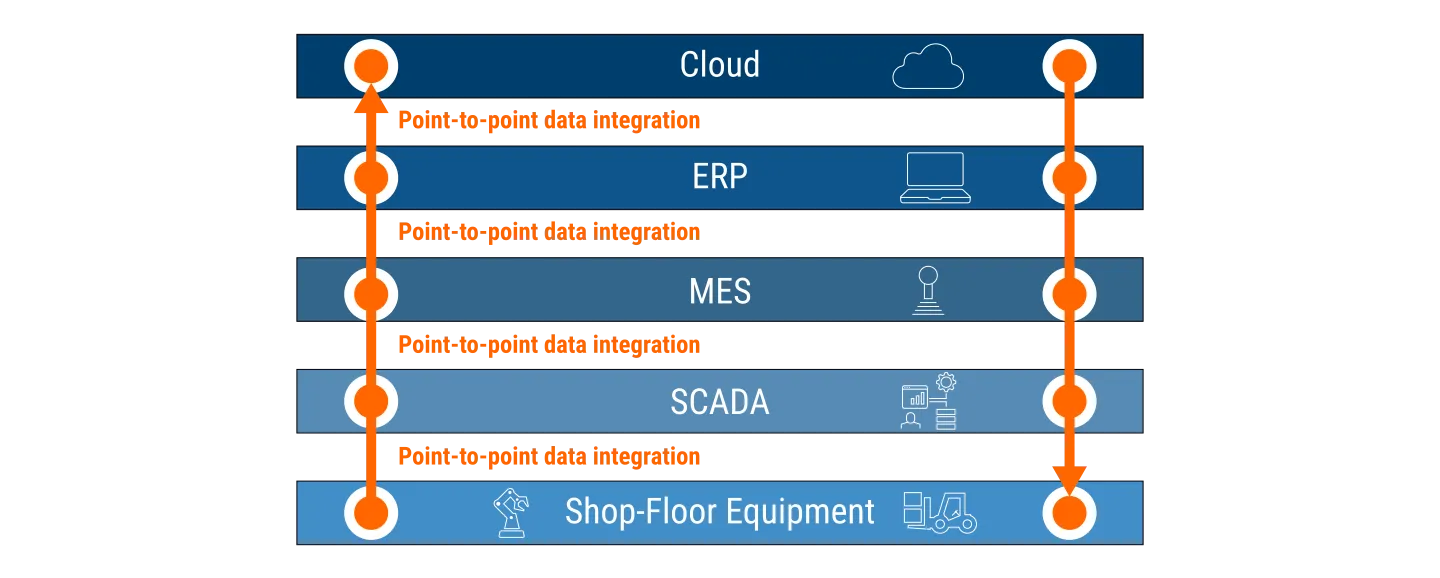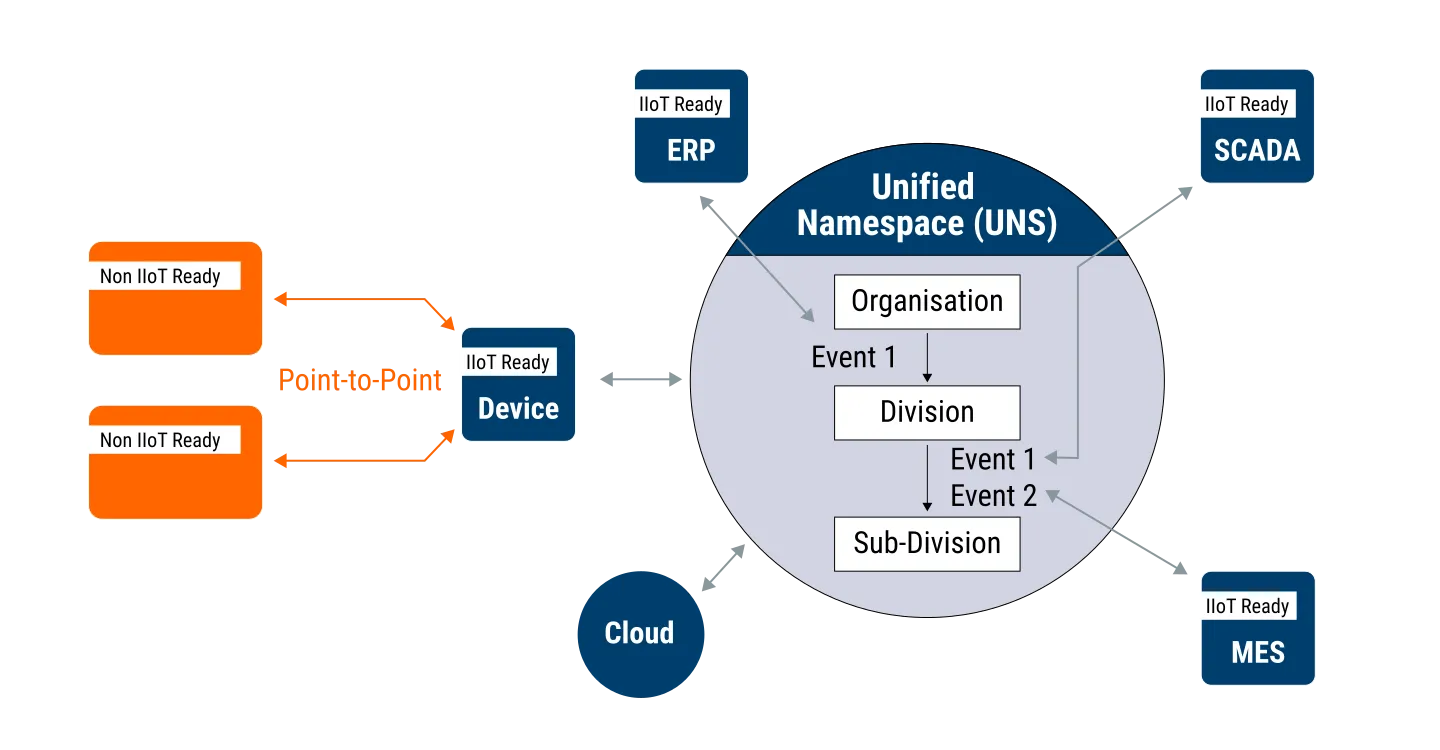What is Unified Namespace (UNS) and Why Does it Matter?
A Unified Namespace (UNS) is an architecture and design pattern for structuring data producers and consumers within a real-time industrial operations environment. By standardizing data from disparate systems, it streamlines data governance, sharing, and analytics. This unified data source ensures stakeholders across the enterprise can access, integrate, and analyze critical insights more efficiently, driving faster decision-making and operational agility.
Welcome to our Unified Namespace (UNS) Essentials series, a practical guide designed for IIoT Solution Architects and Digital Transformation Specialists in manufacturing to utilize this highly efficient architectural approach.
Introduction
If you are like most manufacturers, your primary strategic goal is to become data-driven. Being data-centered allows you to tackle age-old industrial objectives, such as improved productivity and maintenance of equipment while providing a foundation for a fully connected enterprise. The success of such a digital transformation strategy lies heavily on how well-integrated organisational data is across business units and technology domains.
In this article, I will introduce you to the architectural approach superior for achieving digital transformation in manufacturing - the Unified Namespace (UNS). To truly appreciate the significance of UNS, we must begin by highlighting why traditional industrial architecture falls short.
Disadvantages of Traditional Industrial Architecture
Most existing industrial systems model traditional pyramidal network-and-system architectural structure (the ISA 95 functional model). As depicted below, this architectural approach is characterised by a technology stack that includes factory-floor components at the bottom and enterprise/cloud components at the top. Within this stack, each layer is connected and only communicates to a layer that is directly above or below. So, data moves up or down one layer at a time using point-to-point connections. Data movement in a traditional industrial architecture
Data movement in a traditional industrial architecture
While this data architecture served its purpose in the mid to late 1990s with the introduction of PC-based control and enterprise integration, companies are taking big risks by blindly adopting it as the foundation for their digital transformation strategy. Unsighted endorsement often leads to unfulfilled promises, and many digital transformation efforts fail.
You might ask, “Why is that the case?”
Let’s explore an example. Let’s say you intend to make data from a Programmable Logic Controller (PLC) available to an intelligence platform in the Cloud. Using the old ISA 95 functional model, you’d require specialized engineering to get the data into your SCADA system and additional engineering resources to get it from SCADA into MES, and so on, until it lands in the Cloud. What’s worse is that industrial systems use incompatible data formats, meaning each type of equipment or software whose data needs integration requires dedicated engineering effort by different specialists.
Now, besides the apparent astronomical costs and greediness associated with this kind of data integration, here are a few more reasons why a traditional industrial data architecture will lead to failure or non-effective digital transformation efforts.
Not Scalable
Embarking on a digital transformation strategy based on a traditional industrial architecture involves many specialized stakeholders and a lot of manual point-to-point data integration reconciliation. Therefore, it is difficult to scale or meet the demands of modern data-driven manufacturing organizations.
Stifles Innovation
Innovation requires all enterprise network participants (human or otherwise) to have instant data accessibility. However, traditional architectures store data in a centralised data lake where access is limited and minimizes the number of problems it can help solve. Also, this constrains an organization’s ability to respond to the proliferation of data sources.
Accrues Technical Debt
Traditional data integration uses proprietary application interfaces only accessible by specific technology vendors. This leaves companies with hundreds, if not thousands, of point-to-point connections that only a specialized group of people understand.
Results in Data Gaps
This layered architecture limits the scope of data you can collect as a manufacturer. This means you cannot feed intelligence platforms with meaningful data because request-responses data binge-eat bandwidth, are laborious to set up, and are prone to human error. These data gaps have adverse impacts on the business.
These drawbacks collectively make the case that manufacturing businesses should move away from older device-to-device communication and toward more progressive technologies like Unified Namespace.
Ready to implement your own UNS?
HiveMQ is the best MQTT platform to build and implement a Unified Namespace. Contact our solution experts to get started!
Introduction to Unified Namespace (UNS)
To address the failures of traditional industrial data architecture, you need to shift to a paradigm that draws from a modern distributed architecture. Instead of having data exist in silos within and across layers of your technology stack, you make it accessible in a unified way, such that it appears as if it’s all in one place. This enables all your enterprise systems to have one centralised location to get the data they need for what they want to accomplish.
However, to make the data meaningful to all components in your enterprise, you create a standard way of organising and naming the data. The naming convention should reflect the actual structure of your business, from top-level business units down to a control device on the shop-floor. Secondly, the name contains all the events of your business as they happen. The structure is the hierarchy, and the events may, for example, represent a change in temperature, a completed batch, a drop in production line efficiency, or a customer request under a specific level of your hierarchy. This naming arrangement provides a “single source of truth” containing all the data about the structure and current state of the entire enterprise. Unified Namespace (UNS)
Unified Namespace (UNS)
In a nutshell, this is what the Unified Namespace is all about.
The idea is that all components can communicate using IIoT protocols such as MQTT, point to a central repository of information that holds your hierarchical enterprise structure, and publish their events under a category in which it makes sense for that data to live. Components not IIoT ready are placed behind an IIoT gateway that publishes information to the relevant categories on their behalf. Then its location data is available to every participant joining the network.
This allows you to build only one communication interface for your digital infrastructure. Even though point-to-point communication interfaces may still exist behind gateways for collecting data from legacy equipment, as your organization deploys smart assets, you will systematically eliminate them. Enabling your organisation to non-disruptively undergo digital transformation while laying the foundation of your digital future. You are creating a data ecosystem into which all smart entities of your enterprise publish and consume information.
Think about it, by simply plugging into a common network infrastructure: every person working on the plant floor, every piece of hardware and software, including machine learning models, and every high-level decision maker gets instant access to contextualised the most recent enterprise-wide information about the operation of the business. It makes it easy to use your digital infrastructure to solve problems as they arise and predict the future state of your enterprise as your business function are integrated and operate based on information from all other functions, in real-time.
Benefits of Unified Namespace
Simplified Integration
Data producers and consumers are integrated in your data ecosystem by simply plugging them into your network infrastructure.
Reduced Cost of Integration
No specialized engineering services are required to integrate data at each layer of your business.
Improved Agility
Real-time access to the current state of your entire enterprise at any given time improves your capability to test, quickly respond, plan, and predictably deliver.
Scalability
Data producers and consumers are not directly connected; they communicate through a central hub, which enables you to connect up to millions of nodes seamlessly.
Conclusion
While we may have established a foundation for understanding the Unified Namespace in this article, it may prove difficult to grasp it due to its abstract nature. In part 2 of this series, How Does A Unified Namespace Work?, we go into details of how the Unified Namespace works to solidify your understanding of the concept. Read on.
Chapters
- 01:00 - What is Unified Namespace (UNS)?
- 01:18 - Disadvantages of Traditional Industrial Architecture
- 04:51 - Introducing the Unified Namespace
- 07:51 - What are the Benefits of the Unified Namespace?
Navigate this series:

Kudzai Manditereza
Kudzai is a tech influencer and electronic engineer based in Germany. As a Sr. Industry Solutions Advocate at HiveMQ, he helps developers and architects adopt MQTT, Unified Namespace (UNS), IIoT solutions, and HiveMQ for their IIoT projects. Kudzai runs a popular YouTube channel focused on IIoT and Smart Manufacturing technologies and he has been recognized as one of the Top 100 global influencers talking about Industry 4.0 online.

